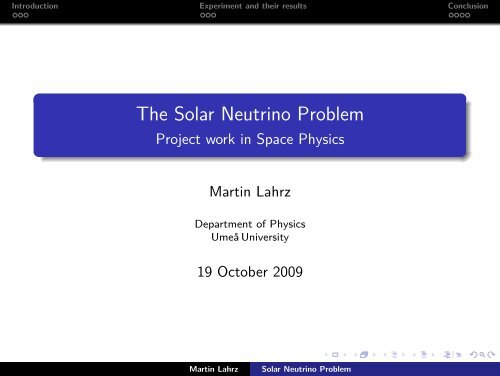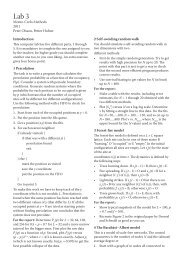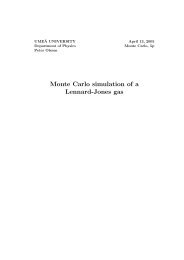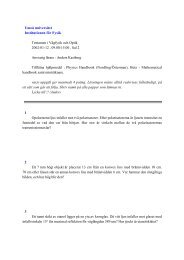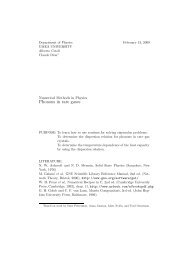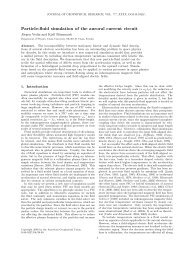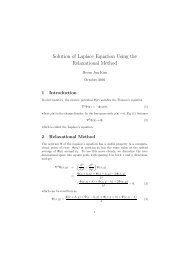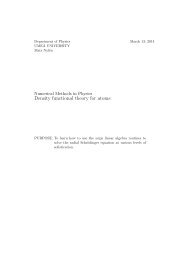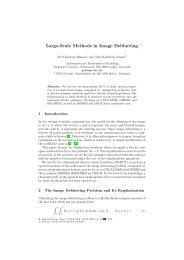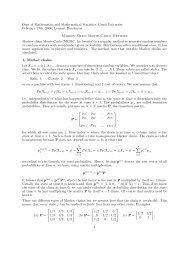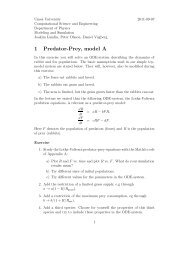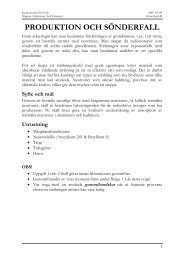The Solar Neutrino Problem
The Solar Neutrino Problem
The Solar Neutrino Problem
You also want an ePaper? Increase the reach of your titles
YUMPU automatically turns print PDFs into web optimized ePapers that Google loves.
Introduction Experiment and their results Conclusion<br />
<strong>The</strong> <strong>Solar</strong> <strong>Neutrino</strong> <strong>Problem</strong><br />
Project work in Space Physics<br />
Martin Lahrz<br />
Department of Physics<br />
Umeå University<br />
19 October 2009<br />
Martin Lahrz<br />
<strong>Solar</strong> <strong>Neutrino</strong> <strong>Problem</strong>
Introduction Experiment and their results Conclusion<br />
Overview<br />
1 Introduction<br />
Outline<br />
<strong>Neutrino</strong>s<br />
2 Experiment and their results<br />
Homestake<br />
SuperKamiokande<br />
Sudbury <strong>Neutrino</strong> Observatory<br />
3 Conclusion<br />
<strong>Neutrino</strong> Oscillations<br />
Outlook<br />
Martin Lahrz<br />
<strong>Solar</strong> <strong>Neutrino</strong> <strong>Problem</strong>
Introduction Experiment and their results Conclusion<br />
<strong>Neutrino</strong>s<br />
<strong>The</strong> Standard Model of particle physics<br />
Open letter to the group of radioactive people at the Gauverein<br />
meeting in Tübingen signed by W. Pauli from Dec. 4, 1930<br />
Dear Radioactive Ladies and Gentlemen,<br />
As the bearer of these lines, to whom I graciously ask you to<br />
listen, will explain to you in more detail, because of the<br />
"wrong" statistics of the N- and Li-6 nuclei and the continuous<br />
beta spectrum, I have hit upon a desperate remedy to save the<br />
"exchange theorem" (1) of statistics and the law of<br />
conservation of energy. Namely, the possibility that in the<br />
nuclei there could exist electrically neutral<br />
particles, which I will call neutrons, that have<br />
spin 1/2 and obey the exclusion principle and that<br />
further differ from light quanta in that they do not<br />
travel with the velocity of light. <strong>The</strong><br />
mass of the neutrons should be of the same order of<br />
magnitude as the electron mass and in<br />
any event not larger than 0.01 proton<br />
mass. - <strong>The</strong> continuous beta spectrum would then make<br />
sense with the assumption that in beta decay, in addition to<br />
the electron, a neutron is emitted such that the sum of the<br />
energies of neutron and electron is constant.<br />
Martin Lahrz<br />
<strong>Solar</strong> <strong>Neutrino</strong> <strong>Problem</strong>
Introduction Experiment and their results Conclusion<br />
<strong>Neutrino</strong>s<br />
Interactions<br />
Now it is also a question of which forces act upon neutrons. For me, the most likely model for the neutron seems<br />
to be, for wave-mechanical reasons (the bearer of these lines knows more), that the neutron at rest is a magnetic<br />
dipole with a certain moment µ. <strong>The</strong> experiments seem to require that the ionizing effect of such<br />
a neutron can not be bigger than the one of a gamma-ray, and then µ<br />
is probably not allowed to be larger than e · (10 −13 cm).<br />
But so far I do not dare to publish anything about this idea, and trustfully turn first to you, dear radioactive<br />
people, with the question of how likely it is to find experimental evidence for such a neutron if it would have the<br />
same or perhaps a 10 times larger ability to get through [material] than a<br />
gamma-ray. [...]<br />
Martin Lahrz<br />
<strong>Solar</strong> <strong>Neutrino</strong> <strong>Problem</strong>
Introduction Experiment and their results Conclusion<br />
<strong>Neutrino</strong>s<br />
<strong>The</strong> Standard <strong>Solar</strong> Model (SSM)<br />
Martin Lahrz<br />
<strong>Solar</strong> <strong>Neutrino</strong> <strong>Problem</strong>
Introduction Experiment and their results Conclusion<br />
Brief overview<br />
1 Introduction<br />
2 Experiment and their results<br />
Homestake<br />
SuperKamiokande<br />
Sudbury <strong>Neutrino</strong> Observatory<br />
3 Conclusion<br />
Martin Lahrz<br />
<strong>Solar</strong> <strong>Neutrino</strong> <strong>Problem</strong>
Introduction Experiment and their results Conclusion<br />
Homestake<br />
Head<br />
Raymond Davis, Jr.<br />
John N. Bahcall<br />
Period 1970-1994<br />
Base<br />
E min<br />
ν e + 37 Cl → e − + 37 Ar<br />
0.814 MeV<br />
Martin Lahrz<br />
<strong>Solar</strong> <strong>Neutrino</strong> <strong>Problem</strong>
Introduction Experiment and their results Conclusion<br />
Homestake<br />
Head<br />
Raymond Davis, Jr.<br />
John N. Bahcall<br />
Period 1970-1994<br />
Base<br />
E min<br />
ν e + 37 Cl → e − + 37 Ar<br />
0.814 MeV<br />
Φ Cl (Homestake) = 2.56 ± 0.16 ± 0.16 SNU<br />
while Φ Cl (SSM) = 7.6 +1.3<br />
−1.1 SNU<br />
Martin Lahrz<br />
<strong>Solar</strong> <strong>Neutrino</strong> <strong>Problem</strong>
Introduction Experiment and their results Conclusion<br />
SuperKamiokande<br />
Head Masatoshi Koshiba<br />
Period 1996-<br />
Base ν e + e − → ν e + e −<br />
E min<br />
5 MeV<br />
Martin Lahrz<br />
<strong>Solar</strong> <strong>Neutrino</strong> <strong>Problem</strong>
Introduction Experiment and their results Conclusion<br />
SuperKamiokande<br />
Head Masatoshi Koshiba<br />
Period 1996-<br />
Base ν e + e − → ν e + e −<br />
E min<br />
5 MeV<br />
(<br />
Φ ES (SK) = 2.42 ± 0.06 +0.10<br />
−0.07<br />
(<br />
while Φ ES (SSM) =<br />
6.5 +0.14<br />
−0.17<br />
)<br />
· 10 6 cm −2 s −1<br />
)<br />
· 10 6 cm −2 s −1<br />
Martin Lahrz<br />
<strong>Solar</strong> <strong>Neutrino</strong> <strong>Problem</strong>
Introduction Experiment and their results Conclusion<br />
Sudbury <strong>Neutrino</strong> Observatory<br />
Head<br />
Arthur B. McDonald<br />
Period 1999-2006<br />
Base<br />
E min<br />
ν x + e − → ν x + e −<br />
d + ν e → p + p + e −<br />
d + ν x → ν x + p + n<br />
5 MeV<br />
Martin Lahrz<br />
<strong>Solar</strong> <strong>Neutrino</strong> <strong>Problem</strong>
Introduction Experiment and their results Conclusion<br />
Sudbury <strong>Neutrino</strong> Observatory<br />
Head<br />
Arthur B. McDonald<br />
Period 1999-2006<br />
Base<br />
E min<br />
ν x + e − → ν x + e −<br />
d + ν e → p + p + e −<br />
d + ν x → ν x + p + n<br />
5 MeV<br />
(<br />
Φ total =<br />
5.54 +0.33<br />
−0.31 +0.36<br />
−0.34<br />
)<br />
· 10 6 cm −2 s −1<br />
Φ e = (1.76 ± 0.05 ± 0.09) · 10 6 cm −2 s −1<br />
Martin Lahrz<br />
<strong>Solar</strong> <strong>Neutrino</strong> <strong>Problem</strong>
Introduction Experiment and their results Conclusion<br />
Brief overview<br />
1 Introduction<br />
2 Experiment and their results<br />
3 Conclusion<br />
<strong>Neutrino</strong> Oscillations<br />
Outlook<br />
Martin Lahrz<br />
<strong>Solar</strong> <strong>Neutrino</strong> <strong>Problem</strong>
Introduction Experiment and their results Conclusion<br />
<strong>Neutrino</strong> Oscillations<br />
A short introduction<br />
Flavor α = e, µ, τ and mass i = 1, 2, 3 eigenstates are not the<br />
same ⇒ linear combination<br />
|ν α 〉 = U αi |ν i 〉<br />
Pontecorvo-Maki-Nakagawa-Sakata (PMNS) matrix U describes<br />
charged-current interaction (beta decay)<br />
Martin Lahrz<br />
<strong>Solar</strong> <strong>Neutrino</strong> <strong>Problem</strong>
Introduction Experiment and their results Conclusion<br />
<strong>Neutrino</strong> Oscillations<br />
A short introduction<br />
Flavor α = e, µ, τ and mass i = 1, 2, 3 eigenstates are not the<br />
same ⇒ linear combination<br />
|ν α 〉 = U αi |ν i 〉<br />
Pontecorvo-Maki-Nakagawa-Sakata (PMNS) matrix U describes<br />
charged-current interaction (beta decay)<br />
Interference through propagation as plane wave (vacuum)<br />
|ν i (t)〉 = e −i(E i t− #» p i · #» x ) |ν i (0)〉 = e −im2 i t/2E |ν i (0)〉<br />
leads to transition probability<br />
(<br />
P α→β = |〈ν β (t) |ν α (0)〉| 2 ∆m<br />
≈ sin 2 2θ sin 2 2 )<br />
L<br />
, (α = e, β = µτ)<br />
4E<br />
Martin Lahrz<br />
<strong>Solar</strong> <strong>Neutrino</strong> <strong>Problem</strong>
Introduction Experiment and their results Conclusion<br />
<strong>Neutrino</strong> Oscillations<br />
Matter effects<br />
Assume two types of neutrinos. Equation of motion:<br />
i d dt |ν〉 = 1 (<br />
−<br />
∆m 2<br />
2 H |ν〉 with H = 4E cos 2θ )<br />
∆m 2<br />
4E<br />
sin 2θ<br />
∆m 2<br />
4E sin 2θ ∆m 2<br />
4E cos 2θ<br />
Martin Lahrz<br />
<strong>Solar</strong> <strong>Neutrino</strong> <strong>Problem</strong>
Introduction Experiment and their results Conclusion<br />
<strong>Neutrino</strong> Oscillations<br />
Matter effects<br />
Assume two types of neutrinos. Equation of motion:<br />
i d dt |ν〉 = 1 (<br />
−<br />
∆m 2<br />
2 H |ν〉 with H = 4E cos 2θ )<br />
∆m 2<br />
4E<br />
sin 2θ<br />
∆m 2<br />
4E sin 2θ ∆m 2<br />
4E cos 2θ<br />
But: matter changes Hamiltonian<br />
(<br />
−<br />
∆m 2<br />
H = 4E cos 2θ + √ )<br />
∆m<br />
2G F N 2<br />
e 4E<br />
sin 2θ<br />
∆m 2<br />
4E sin 2θ ∆m 2<br />
4E cos 2θ<br />
⇒ resonances, Mikheev-Smirnov-Wolfenstein (MSW) effect<br />
⇒ Day/night asymmetry<br />
Martin Lahrz<br />
<strong>Solar</strong> <strong>Neutrino</strong> <strong>Problem</strong>
Introduction Experiment and their results Conclusion<br />
Outlook<br />
Fit Standard <strong>Solar</strong> Model to neutrino flux<br />
8 B flux since Φ( 8 B) ∝ T 25<br />
“monoenergetic” neutrinos 7 Be, pep<br />
Registrate cosmic events, e.g. supernovas<br />
Improve Standard Model of particle physics<br />
Martin Lahrz<br />
<strong>Solar</strong> <strong>Neutrino</strong> <strong>Problem</strong>
Introduction Experiment and their results Conclusion<br />
Thank you for your attention.<br />
Martin Lahrz<br />
<strong>Solar</strong> <strong>Neutrino</strong> <strong>Problem</strong>
Bibliography<br />
Figures<br />
Bibliography I<br />
<strong>The</strong> Super-Kamiokande Collabora al.<br />
Measurements of the solar neutrino flux from super-kamiokande’s first 300<br />
days.<br />
ERRATUM-IBID., 81:4279, 1998.<br />
John N. Bahcall and M. H. Pinsonneault.<br />
<strong>Solar</strong> models with helium and heavy element diffusion, 1995.<br />
John N. Bahcall and Aldo M. Serenelli.<br />
How do uncertainties in the surface chemical abundances of the sun affect<br />
the predicted solar neutrino fluxes<br />
ASTROPHYS.J, 530, 2005.<br />
John N. Bahcall, Aldo M. Serenelli, and Sarbani Basu.<br />
New solar opacities, abundances, helioseismology, and neutrino fluxes,<br />
2005.<br />
Martin Lahrz<br />
<strong>Solar</strong> <strong>Neutrino</strong> <strong>Problem</strong>
Bibliography<br />
Figures<br />
Bibliography II<br />
Alain Bellerive.<br />
Review of solar neutrino experiments.<br />
International Journal of Modern Physics A, 19:1167, 2004.<br />
B. T. Cleveland et al.<br />
Measurement of the solar electron neutrino flux with the Homestake<br />
chlorine detector.<br />
Astrophys. J., 496:505–526, 1998.<br />
SNO Collaboration.<br />
Direct evidence for neutrino flavor transformation from neutral-current<br />
interactions in the sudbury neutrino observatory.<br />
Physical Review Letters, 89:011301, 2002.<br />
<strong>The</strong> SNO Collaboration.<br />
<strong>The</strong> sudbury neutrino observatory.<br />
NUCL.INSTRUM.METH.A, 449:172, 2000.<br />
Martin Lahrz<br />
<strong>Solar</strong> <strong>Neutrino</strong> <strong>Problem</strong>
Bibliography<br />
Figures<br />
Martin Lahrz<br />
<strong>Solar</strong> <strong>Neutrino</strong> <strong>Problem</strong>
Bibliography<br />
Figures<br />
Martin Lahrz<br />
<strong>Solar</strong> <strong>Neutrino</strong> <strong>Problem</strong>
Bibliography<br />
Figures<br />
Martin Lahrz<br />
<strong>Solar</strong> <strong>Neutrino</strong> <strong>Problem</strong>


